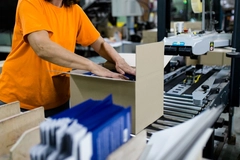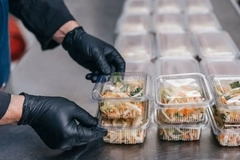Pushing for transparency: Aimplas and Huhtamaki prioritize supply chain partnerships and digital tech

Transparency in supply chain operations is becoming more and more important for businesses seeking to uphold their environmental sustainability claims. Clarity, purpose and action are essential to gain credibility and trust from consumers and value chain stakeholders.
In the plastics sector, Aimplas points out that the main trends regarding the management of logistics are focused on the traceability of the supply chain, the flexibility for customized orders and the speed-up of their management.
Rosa González, researcher in packaging at Aimplas, tells Packaging Insights: “Traceability of information along the value chain is also very important for aspects such as EU Registration, Evaluation, Authorisation and Restriction of Chemicals, food contact plastics legislation and recycled content. Companies need more information to ensure quality, safety and compliance with legislation.”
Huhtamaki also sheds light on how it ensures supply chain compliance. Salla Ahonen, executive vice president, sustainability and communications at the Finnish food packaging specialist , shares: “We prioritize working with responsible suppliers that adhere to our code of conduct, focusing on social and environmental sustainability as well as business ethics.”
Connective technologies
Aimplas recognizes digitalization as a pivotal factor in the sector, enabling enhanced control over the supply chain from raw materials to the production and transport of goods.
“The use of digital tools makes plastic converting processes more accurate, with less raw material losses and waste generation. The use of digital codes, like QR codes, provides information on the different steps involved in the supply chain, improving traceability. The packaging of goods can also be digitalized for logistics control and traceability,” says González.
According to Innova Market Insights’ Packaging Survey 2024, QR codes are among the most recognized packaging technologies, with 47% of respondents reporting high familiarity. In contrast, familiarity with smart labels varies, with nearly 30% of respondents indicating a high level of familiarity.
By utilizing tracking methods such as QR codes or RFID tags, companies can improve the traceability of packaging, making data on reuse cycles and cleaning protocols available to consumers through interactive dashboards or branded web pages. This transparency builds consumer trust and fosters participation in sustainability initiatives.
 Salla Ahonen, executive vice president, sustainability and communications at Huhtamaki.“Regarding the flexibility required for customized orders, the use of key enabling technologies, in particular advanced manufacturing technologies, is a solution either for changeable and small orders or for the production of big size packaging elements like big boxes and pallets,” adds González.
Salla Ahonen, executive vice president, sustainability and communications at Huhtamaki.“Regarding the flexibility required for customized orders, the use of key enabling technologies, in particular advanced manufacturing technologies, is a solution either for changeable and small orders or for the production of big size packaging elements like big boxes and pallets,” adds González.
Strengthening oversight
Managing a network of suppliers worldwide, Huhtamaki employs a risk-based approach to supplier management.
“We categorize suppliers by risk level based on factors like location and spending. Higher-risk suppliers are required to complete questionnaires for further compliance information. We also use audits to ensure ethical practices and follow up on corrective actions when needed,” explains Ahonen.
“We use technology to help mitigate potential risks in the supply chain by enabling the screening of all key suppliers against sanction lists, watchlists and various databases. This digital process allows us to quickly identify potential ESG issues within our supply chain.”
Specialized tools have been developed to help businesses have better data to support sustainability efforts throughout the value chain.
“By using an online tool, we can monitor and act on potential risks in real-time, ensuring a proactive approach to managing compliance and maintaining high ethical standards across our operations. We are currently working on further improving the processes and systems,” Ahonen shares.
“We are continually enhancing our supply chain due diligence to broaden its reach and adopt a more thorough, risk-based approach, aiming for comprehensive coverage across our partnerships.”
Moving forward together
As Huhtamaki highlights, the sustainability landscape is one that no company can navigate alone.
“A key trend in supply chain management is the increasing interest in setting sustainability goals for the entire value chain. We are all dependent on each other and cannot solve the nature or climate or social challenges on our own,” says Ahonen.
“One aspect is related to managing risks, for example, further strengthening our due diligence processes to align with legislative requirements such as the EU Corporate Sustainability Due Diligence Directive and the UN Guiding Principles for Business and Human Rights.”
In a previous interview, Dr. Paul Collins, vice president of sustainability at Huhtamaki, explained how the company’s supplier network spans from small local suppliers to large international providers, delivering raw materials, products and services both regionally and globally. The primary materials sourced include paperboard, recycled fiber, plastics and chemicals.
A more transparent future
Aimplas envisions a future where automation and traceability drive unprecedented transparency across the supply chain.
“In this sense, the product digital passport will be introduced in the sustainable design law. The digital product passport is a digital record that provides complete information about a product and its entire value chain. This includes everything from the origin of the product, materials used, environmental impact and recommendations for waste management and recycling,” elaborates González. Collaboration with various players involved in the value chain can be crucial for manufacturers.
Collaboration with various players involved in the value chain can be crucial for manufacturers.
“In addition, this will also help to cover other important aspects, like the current demands of consumers and their concerns regarding the origin goods and their associated environmental impacts.”
González believes that when it comes to understanding the environmental impact of products, the future is having access to data on the carbon footprint and life cycle analysis of products. Achieving this requires comprehensive information across the entire value chain.
“Currently, due to globalization, it is difficult to have real information and the necessary data and this aspect will have to change,” she says.
“Also, with the publication of upcoming legislation, for example, with eco-design or anti-greenwashing, this transfer of information along the value chain will be mandatory. At this point, we must also not forget the information to consumers with the new labeling rules, which is essential for the proper use and recycling of packaging.”











